Jackie Damrau, Editor
Books Reviewed in This Issue
The reviews provided here are those that are self-selected by the reviewers from a provided list of available titles over a specific date range. Want to become a book reviewer? Contact Dr. Jackie Damrau at jdamrau3@gmail.com for more information.
From Solo to Scaled: Building a Sustainable Content Strategy Practice
Natalie Marie Dunbar
What If? 2: Additional Serious Scientific Answers to Absurd Hypothetical Questions
Randall Munroe
The Knowledge Graph Cookbook: Recipes That Work
Andreas Blumauer and Helmut Nagy
The Dual Enrollment Kaleidoscope: Reconfiguring Perceptions of First-Year Writing and Composition Studies
Christine Denecker and Casie Moreland, eds.
Visual Research: An Introduction to Research Methods in Graphic Design
Russell Bestley and Paul McNeil
Disabilities and the Library: Fostering Equity for Patrons and Staff with Differing Abilities
Clayton A. Copeland, ed.
The Accidental Taxonomist
Heather Hedden
The Innovation Mindset: Eight Essential Steps to Transform Any Industry
Lorraine H. Marchand with John Hanc
The Secrets of Words
Noam Chomsky and Andrea Moro
The Rob Roy Kelly American Wood Type Collection: A History and Catalog
David Shields
Persuasive Communication for Science and Technology Leaders: Writing and Speaking with Confidence
Stephen Wilbers
Transformative Teaching and Learning in Further Education: Pedagogies of Hope and Social Justice
Rob Smith and Vicky Duckworth
Rewired: Protecting Your Brain in the Digital Age
Carl D. Marci, MD
Disability Friendly: How to Move from Clueless to Inclusive
John D. Kemp
Drawing Product Ideas: Fast and Easy UX Drawing for Anyone
Kent Eisenhuth
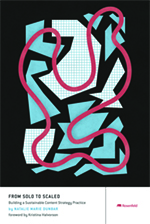 From Solo to Scaled: Building a Sustainable Content Strategy Practice
From Solo to Scaled: Building a Sustainable Content Strategy Practice
Natalie Marie Dunbar. 2022. Rosenfeld Media. [ISBN 978-1-933820-57-6. 220 pages, including index. US$49.99 (softcover).]
From Solo to Scaled: Building a Sustainable Content Strategy Practice by Natalie Marie Dunbar is a book that is sure to be deeply appreciated by its admittedly niche audience—those who are tasked with establishing or growing a content strategy practice. I’m fortunate enough to work at a company that lives and breathes content strategy, so I don’t need to convince my boss about its importance. Many people, however, find themselves in workplaces where they may be the only one even familiar with the “content strategy” term. Dunbar’s book is a compassionate guide for such a reader who needs to boldly step into uncharted territory as a content strategy practice builder at their organization, whether that means scaling an existing team to meet growing demand or starting from scratch.
It’s important to note that From Solo to Scaled is not a book about how to do content strategy, but rather how to erect the organizational scaffolding necessary to sustain and manage the growth of a content strategy practice. Although this kind of work sounds to me like “ContentOps,” the term does not appear in the book’s index, and I wish I could have understood how Dunbar views her advice in the context of this trending idea in the field.
The book consistently delivers helpful samples and figures to inspire the reader. The second chapter, “Structural Alignment,” provides a clear sample charter for a concept I had been unfamiliar with, a “Content Strategy Community of Practice,” which can act as a possible intermediary step before embarking on establishing a full-fledged content strategy practice (p. 45). The third chapter, “Building Materials,” demonstrates how to create a reliably repeatable and scalable end-to-end content strategy lifecycle “Process Framework.” The fourth chapter helps the reader scale and expand their practice’s capabilities by highlighting the various sub-disciplines and competencies within content strategy that will need to be incorporated. There is a helpful sample “Growth Mitigation Strategy” table on pages 92–93 that demonstrates how one can categorize and size content strategy projects by their complexity and necessary phases, approaches, and methodologies.
Throughout the book, Dunbar is careful to not assume a “one-size-fits-all” approach to her advice. However, in her advice to configure the strategies to what’s relevant to the reader’s own practice (p. 93), there is an acknowledgement that a guide such as From Solo to Scaled can only take the reader so far, and at a certain point it is up to them to pick and choose which advice makes sense given their situation. Readers should not expect to have their hand held all the way through the unavoidably ambiguous, difficult, and highly individualized work of establishing a content strategy practice at any organization.
Josh Anderson
Josh Anderson, CPTC, is an Information Architect at Precision Content. Josh was an English teacher in Japan and an SEO Specialist in the Chicagoland area before earning a Master of Information at the University of Toronto.
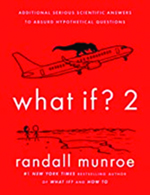 What If? 2: Additional Serious Scientific Answers to Absurd Hypothetical Questions
What If? 2: Additional Serious Scientific Answers to Absurd Hypothetical Questions
Randall Munroe. 2022. Riverhead Books. [ISBN 978-0-525-53711-3. 368 pages. US$30.00 (hardcover).]
I have long been a fan of Randall Munroe’s work, stemming from his excellent webcomic xkcd. Munroe, an engineer-turned-cartoonist, has a knack for seamlessly integrating physics, statistics, and logic into his comics in a way that remains accessible and educational. He has brought this skill to his non-fiction writings, including his newest work, What If? 2: Additional Serious Scientific Answers to Absurd Hypothetical Questions. This book, like its predecessor, is adapted from a segment of xkcd where Munroe answers fan-submitted questions about our world. The result is an entertaining journey throughout the many domains of science and math.
What If? 2 features 64 main questions and several “short answer” sections. The questions vary wildly in scope and topic, ranging from geology (can you make a lava lamp out of actual lava?) to civil engineering (how many men would it take to literally build Rome in a day?) to law (how long would it take to read every law applicable to you?). Many questions were submitted on behalf of children (such as, “what if the solar system was filled with soup out to Jupiter?”)., Munroe seems to take pride in answering these types of questions, perhaps to foster scientific interest in young people. He also has an appreciation for the absurd, and many of his answers discuss the calamities that would ensue from each question. For instance, when discussing the soup question, he describes in detail how the amount of mass needed for the soup would collapse into the Sun and form a black hole, and eventually “the black hole of soup would start slurping up the rest of the Solar System” (p. 4). A dark sense of humor pervades these questions, particularly when Munroe explains in precise detail how our galaxy would be destroyed from something seemingly benign.
What If? 2’s greatest strength is this sense of humor. The book is eminently readable, and the comedy balances the technical information to keep readers engaged. Munroe doesn’t explain every calculation or scientific phenomena, which may bother some readers, but he does an admirable job describing how he approaches most of the book’s questions. The result is a book that perfectly exemplifies technical communication for the masses. Munroe covers concepts such as atomic structures, exponential growth, and even special relativity in entertaining and informative ways that most readers can grasp.
What If? 2 takes joy from exploring the niche cases of science. Indeed, this book reads like a particularly extreme episode of MythBusters, devoted to bombastic yet theoretical tests that could never be conducted in real life. Throughout it all, Munroe highlights the joys of science and the drive needed to seek out the answers to seemingly impossible questions. I wholeheartedly recommend this book to anyone that shares this drive. What If? 2 is a hilarious, fascinating book that overflows with clever examples of technical communication.
Nathan Guzman
Nathan Guzman is a graduate student studying technical communication at the University of Alabama–Huntsville. His background is in aerospace engineering with plans of becoming a full-time editor upon graduation. Nathan is an avid reader with interests in reading anything that expands his knowledge of the world and how it works.
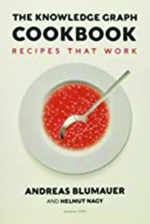 The Knowledge Graph Cookbook: Recipes That Work
The Knowledge Graph Cookbook: Recipes That Work
Andreas Blumauer and Helmut Nagy. 2020. edition mono/monochrome. [ISBN 978-3-902796-70-7. 256 pages. US$32.00 (softcover).]
Like a delectable meal that is a feast for both the eyes and stomach, the visual design of The Knowledge Graph Cookbook: Recipes That Work is sumptuous. The tables and graphics are understandable, informative, and colorful, and serve to lift text that is complex and technical. The overall book layout is a masterclass in technical communication document design. Whether all kudos belongs to Härtig, the cover artist and layout designer, or in combination with authors Andreas Blumauer and Helmut Nagy, adding this book to your bookshelf as an excellent example of design is a must. Regarding its addition as an excellent source of knowledge graph information, that is less clear. Why? Because it still feels technical and perhaps there is no way around that when it comes to knowledge graphs and their relationship to “data governance, metadata management, and data enrichment, and … data integration technology” (p. 2). It is, by its nature, technical and complex.
Blumauer and Nagy do not skimp on the book’s contents. You will leave satiated. This is a thorough exploration of knowledge graphs that begins with a brief history, includes core concepts, basic principles, methodologies, life cycles, and best practices, and ends with a look into the future and what is next in terms of graphs. Having worked with organizations to create and implement knowledge graphs, the authors tackle the hard issues around organizational culture roadblocks and the various role-based personalities that can add to or subtract from knowledge graph successes in a section of the book smartly titled “Personas: Too Many Cooks” (p. 76).
Readers will appreciate the expert opinion interviews included by the authors. “Good chefs regularly visit other restaurants for inspiration. We have asked experts working in the field of knowledge graphs and semantic data modelling to comment on their experience in this area. They have worked with various stakeholders in different industries, so that you, dear reader, may further develop your understanding of the topic” (p. 162). These perspectives round out approaches to knowledge graphs and how they can be used effectively in organizations with stakeholder buy-in. The list of frequently asked questions at the end of the book, while not exhaustive, is also helpful to readers ready to launch their knowledge graph journey using the ingredients pulled together by Blumauer and Nagy.
While The Knowledge Graph Cookbook is a great accompaniment to readers familiar with knowledge graph concepts, those newer to the field or less technically savvy may need some additional cooking instructions and training to achieve a full feast. Like a fine wine paired with a great meal, this cookbook is best paired with some instructor-led training and hands-on practice.
Liz Herman
Liz Herman, PhD, is an STC Associate Fellow and a knowledge management practitioner and is certified in project management and technical communication. She works as a senior manager for a large consulting firm.
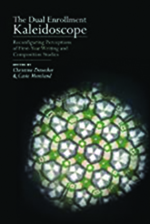 The Dual Enrollment Kaleidoscope: Reconfiguring Perceptions of First-Year Writing and Composition Studies
The Dual Enrollment Kaleidoscope: Reconfiguring Perceptions of First-Year Writing and Composition Studies
Christine Denecker and Casie Moreland, eds. 2022. Utah State University Press [ISBN 978-1-64642-252-4. 270 pages, including index. US$33.95 (softcover).]
A kaleidoscope uses angled mirrors to make patterns, no two of which are exactly alike. Likewise, views regarding dual enrollment (DE) vary by the student, schools, and those who teach. This book’s editors, Christine Denecker and Casie Moreland, use thoughts presented by the writers of fourteen papers to consider location and mode of delivery aspects covering DE.
- Educational Training Issues
- Senior year at High School versus College Freshman year. Location and grade level have often been considered. Chapter 10 discusses current and normal.
- Credits. Will credits be applied at college level; which school will this be determined? (See Chapter 11 for this discussion).
- Beyond College English Preparation. Besides basic English and grammar, what other aspects of writing should be taught? High school is responsible for business level teaching according to Chapter 12.
- Teacher Skills. Who decides what teachers should have for experience? Are they to blame if students lack success? (See Chapter 14 for this discussion).
- Gap Deficiencies.
- Racial and Social Concerns are covered in Chapter 1.
- If basic English and grammar are the only topics, could this create racial and social concerns?
- Would it be more useful for minority students to stress these at an earlier grade level?
- Other Important Training (Not Discussed)
- Personal Reading. This is a source of training for many writers.
- Library Usage. Important for teaching research abilities to students. Also, a resource for demonstrating company guidelines to follow.
This book may prove more valuable for those in the educational field. Good basic writing skills must be developed somewhere before the corporate world. And development of these skills should begin the sooner the better. We technical communicators probably agree wholeheartedly until this point.
The editors and their contributors, however, challenge us to consider what is really happening in the educational world and how it could be improved. Such an important subject deserves input from various writing groups. Our opinions are valuable because every technical communicator personally experienced training somewhere, even those who did not have DE available as an option.
Donna Ford
Donna Ford has been an STC member and a technical writer in the hardware, software, IT, and government healthcare industries. She holds an Information Design certificate from Bentley College. Donna is an author who also has reviewed trade books online for the US Review of Books.
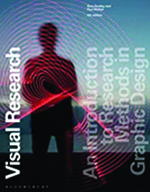 Visual Research: An Introduction to Research Methods in Graphic Design
Visual Research: An Introduction to Research Methods in Graphic Design
Russell Bestley and Paul McNeil. 2022. 4th ed. Bloomsbury Visual Arts. [ISBN 978-1-3501-6056-9. 256 pages, including index. US $44.95 (softcover)]
If you were given a single text, an amazingly designed and insightfully thorough text, which would walk you through the vast topics of visual design from research pedagogy to synthesis, then you would be holding a copy of the stunning 4th edition of Visual Research: An Introduction to Research Methods in Graphic Design by Russell Bestley and Paul McNeil.
First published in 2004, the latest edition includes over 300 color illustrations of art and design processes. The book has evolved into a tour de force on topics ranging from structuralism and semiotics to gestalt and the politics of design. The writing is dense and uncompromising, this is not a coffee table “browser” though it might be mistaken for such given the superb quality of the paper and printing.
The opening quote from Chapter 5, Theory in Practice, excellently represents the analytical depth that is pervasive throughout the volume: “Contemporary graphic design is not always concerned with problem-solving. The exploration of a theme and the graphic response to that theme is a core part of the research agenda. In effect, this places the design methodology itself as a central component of the design process” (p. 121).
One of the important strengths of Visual Research is the inclusion of case studies, nineteen in total, linked to each chapter’s contents and reflecting those concepts and their application in real world design scenarios. Case Study 12, “The English Difference,” is a perfect example. The design concept (by Gemma Dinham) reflects the common British use of irony and self-deprecation as a standard form of humor by creating cloned parodies of favorite alcoholic drinks; beautifully labeled and designed containers with names such as “Detachment” and “Cynicism.” Thus, she holds up a sarcastic graphic design mirror to the very British relationship between class, social etiquette, and alcoholic drinks. This neatly epitomizes the essence of visual research.
Working through the chapters, one appreciates the nearly 20 years of revisions and improvements that have led to this fourth edition. The flow of ideas and visuals within each chapter and throughout the text reflect the authors honed experience. As an aside, there is an excellent “Key Concepts” final chapter and an eminently useful directory of terminology for students, teachers, and researchers.
The immense amount of visual material, and the text’s refined nature, make this a very difficult book to synopsize. This is a heavy book (good paper and all), and its substantial physical heft is paralleled in the mass of its contents. It takes a committed reader to handle page after page of graphic iterations and text saturated with insightful quotes by prominent designers and authors. In short, it’s a challenging text; this is the ultimate compliment!
Lynne Cooke
Lynne Cooke is a Clinical Assistant Professor at Arizona State University where she teaches courses on usability, digital media, and portfolio development. She is also a member of the Arizona Chapter of STC and the Internship Coordinator at ASU.
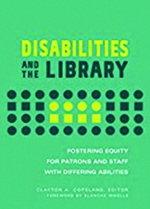 Disabilities and the Library: Fostering Equity for Patrons and Staff with Differing Abilities
Disabilities and the Library: Fostering Equity for Patrons and Staff with Differing Abilities
Clayton A. Copeland, ed. 2023. Libraries Unlimited. [ISBN 978-1-4408-5907-6. 508 pages, including index. US$60.00 (softcover).]
Disabilities and the Library: Fostering Equity for Patrons and Staff with Differing Abilities addresses the challenges in providing universal access to library patrons and community members. Many of its strategies can be applied broadly across a range of communication and educational disciplines.
The chapters are written by diverse professionals: information scientists, engineers, administrators, and of course, librarians. Many are also differently abled. However, common themes emerge. The biggest takeaway is that accommodating differently abled individuals is integral to the mission of a library—information access for all—but in practice, accommodations improve the library experience for everyone.
Parts I and II provide a brief history of disability rights and an introduction to the visible and “hidden” disabilities library staff may encounter from mental illness, dyslexia, and neurodevelopmental disorders like ADHD and autism spectrum disorder to more traditionally defined disabilities including blindness and deafness. The most basic step is for staff to have readily available contact information for local services and directions to online resources. Additional steps can serve multiple populations at once: providing materials in “multiple modalities,” such as an audiobook and book format simultaneously, can improve fluency for readers with dyslexia but also serves those with low vision (pp. 103, 126). Clear signage in the physical space also benefits all patrons: signs should be large print with high contrast between text and background, and color-coding should be supplemented with clear icons for the color blind.
Parts III and IV explore creating inclusive collections, programming, and spaces, both physical and digital. Inclusive collections include materials that portray persons with disabilities in an authentic way, allowing younger patrons to see themselves represented on the page or screen. Inclusive programming might include adaptive storytime with a multisensory approach: “Using tactile tools like story boxes or baskets, which contain tactile manipulatives that represent characters and items in the story can help reinforce comprehension” (p. 281). The physical environment must also be inclusive. Design considerations should extend beyond legislative minimums like wheelchair ramps to consider universal design that will improve the experience for all patrons. The library is not a place for architectural frills: unexpected or oddly shaped stairs, cavernous atriums, and ill-placed skylights put patrons on edge. Navigable spaces with minimal obstacles benefit everyone.
Chapters 16 and 17 about online accessibility are applicable to all communication professionals. Since a website is often a person’s first experience, adhering to web accessibility standards is critical for accommodating all populations: use consistent heading and subheading architecture to structure content, provide alt text for images, and use CSS and other techniques to make your design responsive to resizing. Content must be formatted in accessible ways; videos should be captioned; PDFs should be tagged to be compatible with screen readers; and website structure must be simple and clear.
Part V explores developing a diverse library staff through inclusive hiring practices and attitudes. Administrators should recognize that persons with disabilities can provide unique insight into the experiences of patrons with disabilities.
Disabilities and the Library offers an introduction to creating inclusive physical and digital environments. Many accommodations for persons with disabilities benefit larger populations. I would recommend Disabilities and the Library to librarians and those in related technology fields, as well as anyone interested in accessibility and disability activism.
Bonnie Winstel
Bonnie Winstel is the Assistant Manager of Software Development for Book Systems, Inc. in Huntsville, Alabama. She received her master’s degree in English and Technical Communication at the University of Alabama-Huntsville in 2013.
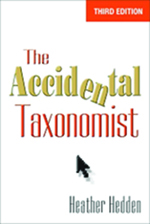 The Accidental Taxonomist
The Accidental Taxonomist
Heather Hedden. 2022. 3rd ed. Information Today, Inc. [ISBN 978-1-57387-586-8. 514 pages, including index. US$47.50 (softcover).]
As Stephanie Lemieux says in her foreword, this text “covers much of the new ground taxonomists need to be aware of for modern practice” (p. x). It’s presented, once again, in a manner practical, useful, and substantive.
The first four chapters (“What Are Taxonomies?,” “Who Are Taxonomists?,” “Creating Terms, Concepts, and Labels,” and “Creating Relationships”) are thorough. Chapter 5, “Software for Taxonomy Creation and Management”, covers the types of software available for creating and managing taxonomies as well as the benefits and features of dedicated taxonomy management software, and taxonomy/thesaurus/ontology software products.
Chapters 6 and 7 cover types of taxonomies: “Taxonomies for Human Indexing” and “Taxonomies for Automated Tagging and Categorization.” Chapters 8–11 get into the nitty gritty of working with taxonomies: “Taxonomy Structures,” “Taxonomy Displays,” “Taxonomy Planning, Design, and Creation,” and “Taxonomy Implementation and Evolution.”
This third edition also includes a new chapter on ontologies, which provides a “high-level introduction to ontologies” (p. 421) and which I found fascinating. “Taxonomists often change jobs and industries,” Hedden says (p. 407), so she also includes a section describing recommended methods for creating ontologies, including design approaches, combining taxonomies and ontologies, determining property types, management software, and ontology work. Some taxonomists/ontologists may be known as “Knowledge Modelers,” she reports.
The last chapter, “Taxonomy Work and the Profession”, gets into more career and professional development. The appendices include a survey of self-described taxonomists from various online groups, as well as a detailed Glossary, Recommended Reading, and Websites.
The index is comprehensive, detailed, and lengthy, so much so that it’s in a much smaller font than the rest of the book and you may want to zoom in for readability—a reason to invest in an electronic as well as a printed edition.
Either way you purchase The Accidental Taxonomist, 3rd edition, it will be a worthwhile investment.
Pilar Wyman
Pilar Wyman, Chief Indexer at Wyman Indexing, has been writing indexes for over 32 years. She is a former STC member and a current member of the American Society for Indexing (ASI). Pilar works in English, Spanish, and French in public health, clinical medicine, med-tech, and other areas of personal interest.
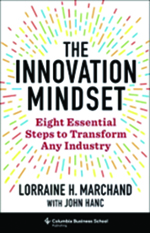 The Innovation Mindset: Eight Essential Steps to Transform Any Industry
The Innovation Mindset: Eight Essential Steps to Transform Any Industry
Lorraine H. Marchand with John Hanc. 2022. Columbia University Press. [ISBN 978-0-231-20308-1. 320 pages, including index. US$30.00 (hardback).]
The Innovation Mindset: Eight Essential Steps to Transform Any Industry is a well-written practical book for anyone interested in understanding innovation and learning how to apply an innovation mindset to identifying the problem around personal/business matter subjects and solve the problem as progressing the author’s essential steps. The idea of an innovation mindset improves productivity and results in sustainable business.
Lorraine H. Marchand suggests observing three problems a day, diagnosing the right problem (p. 27, provides technique), and avoiding jumping to think about solutions instead of the problem. She also refers to Albert Einstein’s quote and spends 91% of her time thinking about the problem and 9% thinking about the solution. I tried this approach the past month; it challenged me to think and identify the encountered problem around my personal and business matters in a different way. I started to tackle the problems that I listed in my notebook. These tactics helped me improve my problem-solving skills. The author also emphasized good ideas, including curiosity, passion for problem-solving and embracing changes.
In Chapter 3, Marchand describes the Minimum Viable Product (MVP) concept, which Frank Robinson introduced in 2001. The MVP concept provides benefits such as making reality from the idea, showing the product to the customer early and obtaining possible feedback on any early correction, and reducing costs and time. The author explains this with eight different MVP types and common testing approaches’ techniques (pp. 62–64).
I enjoyed learning in Chapter 1 and 4 about McKinney’s favorite killer Questions (p. 35), developing my killer questions and the law of one hundred customers, which provides the six best questions for hearing the customer voice. The author gives detailed directions with practical examples. In Chapter 5, the Pivoting terminology was emphasized along with its five reasons for using it (p. 99). I understand why pivoting is pivotal for success and finding the opportunity in terms of strategy. The following section of the book discovers six famous and successful pivots stories. The key is critical thinking.
Overall, The Innovation Mindset is easy to read and contains step-by-step approaches with many examples to help understand the innovation mindset. Readers can apply/transform their personal/ business situations.
Sam Lee
Sam Lee is an STC member and a Policies & Procedures SIG co-manager. Sam has a Master of Technology Management, Master of Electrical Engineering, and a Technical Writing Certificate at the University of Waterloo. He is currently a Senior Avionics Engineer where he designs avionics systems and writes aviation-related documentation.
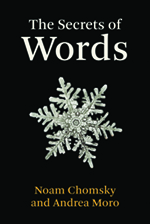 The Secrets of Words
The Secrets of Words
Noam Chomsky and Andrea Moro. 2022. The MIT Press. [ISBN 978-0-262-04671-8. 130 pages. US$17.95 (hardcover).]
For centuries, scientists and philosophers have contemplated how humans acquire language. Galileo, among others, was amazed “that with just a few symbols you can construct infinitely many thoughts” to convey to others the “innermost workings” of your mind (p. 40). And, for centuries, it had been thought that these symbols must be taught, that children must learn words from those who already know them, string them together in a way that makes sense to them, and convey that sense to others. But that idea began to be questioned in the 20th century.
In The Secrets of Words, linguist Andrea Moro interviews linguist Noam Chomsky about how the study of linguistics has changed, specifically in the quest for a solution to that centuries-old puzzle that Chomsky calls “a core problem of the study of language” (p. 40). Excitement started building in the linguistic community in the 1950s about a possible solution. Chomsky compares this to the current excitement about the promise of technology. Linguists started applying scientific analysis to language, and eventually made the connection between language and neuroscience. Early 21st-century experiments demonstrated that, indeed, very young children don’t learn language from what they hear, but from some internal language created in the brain. “Two-year-old children…ignore 100 percent of what they hear…in applying the rules of their internal language” (pp. 15–16).
How this happens is one of the secrets yet to be discovered. It is necessary to move beyond description to explanation. What happens in the brain can be described, but “what is the actual information one neuron passes to another” (p. 30)? Chomsky, who has done extensive research on the history of linguistics, discusses past theories and approaches, such as Galileo’s thought experiments and 20th-century efforts to unify chemistry and physics, and how they may or may not apply to today’s quest to unravel the intricacies of language. Although many mysteries remain unsolved, he does not believe analyzing masses of data by computer has yet to provide the answer to unifying neurosciences with the nature of language. Neurolinguist inquiries may, or may not, unlock the answers to this tantalizing secret.
As a nonlinguist, The Secrets of Words presented me with a look at a fascinating linguistic quandary. Despite the vocabulary of the conversation naturally tending toward linguistic terminology, I appreciated Chomsky’s ability to make his statements clear to me, providing me an excellent lesson in technical communication. The book’s conversation is followed by notes on Chomsky’s work by Moro, one of his former students. For a reader unfamiliar with Chomsky’s contributions to linguistics, it may be worthwhile to look at this before reading the interview.
Linda Davis
Linda M. Davis is an independent communications practitioner in the Los Angeles area. She holds an MA in Communication Management and has specialized in strategic communication planning, publication management, writing, and editing for more than 25 years.
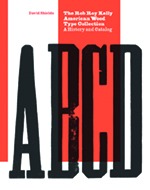 The Rob Roy Kelly American Wood Type Collection: A History and Catalog
The Rob Roy Kelly American Wood Type Collection: A History and Catalog
David Shields. 2022. University of Texas Press. [ISBN 978-1-4773-2368-7. 408 pages, including index. US$65.00 (hardcover).]
Rob Roy Kelly was a graphic designer, design educator, and noted historian, but perhaps his most significant contribution was his collection of “150 faces…and 18,829 pieces of wood type” (p. 01) that would become known as the Rob Roy Kelly American Wood Type collection. As the name states, The Rob Roy American Wood Type Collection: A History and Catalog, by David Shields, contains both a history of the wooden movable type in the collection, which is housed today at the University of Texas, but also a catalog of the collection. This book also tells the histories of Rob Roy Kelly himself and how he began the work of collecting, researching, and cataloging this essential part of our history which resulted in his notable publication American Wood Type 1828-1900.
Today wooden moveable type and their histories are solidly considered part of the graphic design history canon, but that wasn’t always the case. Rob Roy Kelly began collecting wooden type in the 1950s–1960s when it was largely discarded as outdated technology. As Shields notes without the efforts of Kelly, who “fostered a broader acceptance of this…largely ignored, facet of American…history” (p. 01) it might have been forgotten forever.
Organized into five sections, The Rob Roy American Wood Type Collection includes an introduction, a collection of essays on Rob Roy Kelly and his work on the collection, the history of the collection including identification techniques and catalogs, an explanation of classifications of wooden type, and finally images of the collection. Shields highlights and acknowledges Rob Roy Kelly’s incredible work in researching this history while also correcting it as necessary and expanding on it. Shields does an excellent job of explaining Kelly’s research methods. This content could be used as a road map for investigating new histories on overlooked subjects as there was no established method for identifying and researching wooden movable type before Rob Roy Kelly’s work.
Though the book is over 400 pages it is not a difficult read, and more than 300 pages of the book are the specimens themselves. Each specimen includes a short description of the type and an image to represent that typeface, whether it is a historic type specimen from a catalog or in some cases a photograph of the wooden types themselves. When possible, the catalog pages include the name of the typeface, its method of production, and which manufacturer(s) produced it, along with other descriptive and historic details.
The Rob Roy American Wood Type Collection is an extraordinary book that will be enjoyed by historians, design educators, and typophiles. The book is an excellent resource for anyone who is interested in the collection but perhaps unable to make a trip to visit it. It is a beautiful book and not only is it a testament to the significance of Rob Roy Kelly’s work and to the significance of this important yet almost forgotten element of American history. As Shields reminds us, “The history of America…was printed in wood type” (p. 23).
Amanda Horton
Amanda Horton holds an MFA in Design and teaches graduate and undergraduate courses at the University of Central Oklahoma (UCO) in design history, theory, and criticism. She is also the director of the Design History Minor at UCO.
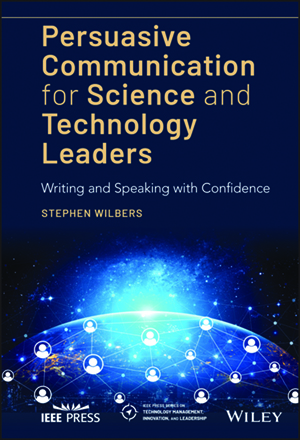 Persuasive Communication for Science and Technology Leaders: Writing and Speaking with Confidence
Persuasive Communication for Science and Technology Leaders: Writing and Speaking with Confidence
Stephen Wilbers. 2023. Wiley/The Institute of Electrical and Electronic Engineers. [ISBN 978-1-119-57322-7. 251 pages, including index. US$95.00 (hardcover).]
Persuasive Communication for Science and Technology Leaders: Writing and Speaking with Confidence is packed with excellent advice on both written and spoken communication, with clear explanations of their differences. Throughout, Stephen Wilbers emphasizes what I’ve always described as the editor’s goal: to translate between the communicator’s mind and their audience, thereby transmitting the essential message—in short, he reminds us to write with the reader, not exclusively the writer or their message, in mind. Refreshingly, he also reminds us of the growing modern audience who don’t speak our language as natives or who speak it differently (e.g., MU.K. versus U.S. usage).
The book’s structure is simple but effective, with a page layout and format that facilitate skimming. Chapters begin with a summary preview and end with highlights, questions to stimulate thought, and exercises to test our mastery of the principles, plus linguistic wordplay as a palate cleanser before moving on. The writing’s friendly, informal, and prescriptive without being dogmatic. The chatty, relaxed style demonstrates Wilbers’ belief that technical writing needn’t be dry and lifeless. He’s humorous and writes with tongue firmly in cheek (“The best way to impress your reader is to show off your knowledge.”, followed by a description of why this is wrong; p. 58), though the humor’s sometimes overdone and leads him astray (“Rhythm is…also for…birth control”, p. 75).
Scientific communicators have long known that any audience contains people who won’t be persuaded by facts, clear writing, or an engaging style alone. Wilbers suggests we can resolve this problem through passionate, credible engagement that establishes our trustworthiness and acknowledges our audience’s concerns and fears, but says little about what arguments might persuade those who find facts alone unconvincing. He notes, “Technological leaders need to do more than inform. They also need to persuade and inspire” (p. xxvi). But he provides no chapter on what makes an effective argument that can overcome resistance; there are hints implicit in his description of persuasion, but a chapter with a more explicit treatment would have improved the book. Although Wilbers reminds us of the importance of personalizing an argument, and the subjectivity of all writing, his suggestion to aim for rigor and objectivity to mitigate that subjectivity is insufficient.
You can read this slim volume quickly, but you’ll benefit more if you take time to think through what Wilbers says and complete his proposed exercises. Persuasive Communication is a great starting point for beginners, a great refresher course for experienced communicators, and a solid addition to any writer’s or editor’s library. But it isn’t the only style guide you’ll need, particularly given the inadequate index. You’ll still want larger references such as The Chicago Manual of Style to provide details of style.
Geoff Hart
Geoff Hart is an STC Fellow with more than 30 years of writing, editing, translation, and information design experience. He’s traveled widely and worked with authors from many cultures. He’s the author of two popular books, Effective Onscreen Editing and Writing for Science Journals.
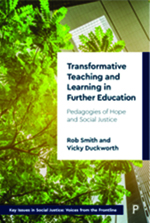 Transformative Teaching and Learning in Further Education: Pedagogies of Hope and Social Justice
Transformative Teaching and Learning in Further Education: Pedagogies of Hope and Social Justice
Rob Smith and Vicky Duckworth. 2022. Policy Press. [ISBN–978-1-4473-6233-3. 224 pages. $45.95 (softcover).]
Rob Smith and Vicky Duckworth based their book, Transformative Teaching and Learning in Further Education: Pedagogies of Hope and Social Justice, on conclusions from the Transforming Lives research project that provided an opportunity to “affirm the primary purpose of education” (p. 9). This research developed “case studies from colleges and adult education settings” (p. 10).
The authors looked at the research related to the impact of education and how it can be transformative as with testimonies from teachers and students. Smith and Duckworth argue that college and lifelong learning can have a positive impact on social justice issues not only for individuals, but also for families and communities. Consider these snippets from students about the positive impact education has had for them:
“When you can’t read and write out there, it’s really hard. And it’s scary. Now I can actually read and write and sign my own name. When I go to the doctor I can sign a note… You need education to learn about everything that’s going on outside” (p. 76).
“Given the opportunity to further myself, that’s a no-brainer. But then coming to college, that first day, I was like: I’m not sure I can do this… It’s changed me. I can do things. I am capable… Now I feel like I’ve got a bit of respect. It’s definitely life-changing” (p. 84).
These snippets speak for themselves as does the following from a teacher:
“I think she then made another change in me just kind of… from going there to get the course done for the sake of getting a qualification to actually wanting to learn and develop. I think it’s one of the reasons I’m teaching as well because of the impact she had on me” (p. 92).
Students, teachers, researchers, and policy makers could find this book to be a valuable resource as the authors explain the sometimes not appreciated and not measured “holistic” benefits of further education.
Jeanette Evans
Jeanette Evans is an STC Associate Fellow; active in the Ohio STC community, currently serving on the newsletter committee; and co-author of an Intercom column on emerging technologies in education. She holds an MS in technical communication management from Mercer University and undergraduate degree in education.
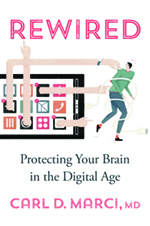 Rewired: Protecting Your Brain in the Digital Age
Rewired: Protecting Your Brain in the Digital Age
Carl D. Marci, MD. 2022. Harvard University Press. [ISBN 978-0-674-98366-3]. 272 pages, including index. US$27.95 (hardcover).]
When you wake up, do you check your cell phone for email and messages? As you go through your day, do you check your schedule on your phone? Do you pay for your morning coffee with your smartphone? When you meet a friend for dinner, do you check your phone for directions to the restaurant? Think of how many times each day you check your cell phone. This didn’t used to be the case.
In his book, Rewired: Protecting Your Brain in the Digital Age, Dr. Carl D. Marci, a leader in the fields of social and consumer neuroscience, describes how the digital age is affecting us. We are distracted. He warns that digital distractions can lead to death. There are serious incidents like texting while driving. Also, there are physical mishaps caused by being distracted. For example, Marci cites how a tourist died after slipping down steps while posing for a selfie. He also mentions the woman who fell into a water fountain inside a mall while walking and using her smartphone.
Dr. Marci points out, “We can access, and even create, media content while standing in line at the store, walking down the street, on break at work, or while sitting in a car, bus, train, or airplane” (p. 100).
Because we can access information later using the internet, we don’t feel a need to remember it. Therefore, our brain alters the way we encode or store memories. And now, with our cell phones and hand-held devices, we are also becoming distracted during our day which may be hampering our sleep patterns. Also, we are less engaged with people and experiences than we used to care about. In fact, today’s young adults have media attention spans significantly closer to those of three-year-olds than to those of adults. Everyone’s brain, from early childhood to adults, is being assaulted with a direct impact on our mental health.
In Chapter 9, Ten Rules for a Healthy Tech-Life Balance, Marci suggests we stop multitasking, pointing out, “When switching from multitasking to monotasking, we will quickly find that we are more focused, more productive, and more attentive to others” (p. 173).
Another rule is to think before you post. Marci spotlighted a school district just minutes from my home, the Mounds View Public Schools, that created a mnemonic to help students to review their online comments before posting: T.H.I.N.K. Is the message True, Helpful, Inspiring, Necessary, and Kind? This pneumonic reminds us to consider actions and consequences before posting.
Having done brain research before entering the technical communication field, I found Marci’s focus on neuroscience to be eye opening. His book, which was easy to read, includes over 30 pages of references. I especially appreciated his tips chapter where he offers suggestions for better dealing with our digital age and the lure these devices have on our brains to affect our attention span, decision making, and the ability to build connections with others.
Rhonda Lunemann
Rhonda Lunemann is an STC senior member and a technical writer with Siemens Digital Industry Software. She serves on the STC Twin Cities chapter’s Program Committee and is a member of the MN (Minnesota) Bot Makers.
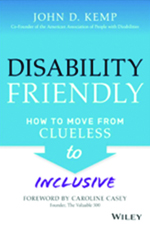 Disability Friendly: How to Move from Clueless to Inclusive
Disability Friendly: How to Move from Clueless to Inclusive
John D. Kemp. John Wiley & Sons, Inc. [ISBN 978-1-119-83009-2. 256 pages, including index. US$28.00 (hard cover).]
We would all like to believe that the companies we work for practice the diversity and inclusion hiring strategies they profess to support. After all, diverse employees lead to better ideas. Unfortunately, for many companies, the disability inclusive initiatives never make it from the policy stage to implementation. In Disability Friendly: How to Move from Clueless to Inclusive, John D. Kemp outlines how businesses can construct and implement better hiring initiatives for disabled workers.
The author provides firsthand knowledge in Disability Friendly about what it is like navigating the world and the workplace with a disability. He writes with gentle humor and humility about his experiences while educating his readers about the nature of disability, how disabled employees can make significant contributions to a company and give the company a better insight into their market.
Throughout Kemp’s discussion, he makes a compelling case that companies need to do more to hire and retain workers with disabilities. Since the passage of the Americans with Disabilities Act (ADA) in 1990, companies have only made a 1–2% increase in the hiring of workers with disabilities. This dismal statistic, along with other evidence presented by Kemp, shows that American companies have a long way to go before they can truly claim to be “inclusive” (pp. xxi–xxii).
Disability Friendly outlines concrete strategies for recruiting, hiring, and retaining employees with disabilities. Kemp’s suggestions are well supported by evidence and personal anecdotes and are often surprising. For example, he explains that most adaptations needed to support disabled workers do not cost the company anything at all, especially since remote work has become more typical since the COVID epidemic began. Other suggestions seem to be common sense, such as making sure that employees with physical disabilities are included in photos on company websites and on hiring materials.
The only area where I found Kemp’s discussion lacking was in discussing invisible disabilities, such as autism or attention-deficit/hyperactivity disorder (ADHD), that may require more than just physical workplace adaptations. As someone with one of these disabilities, I wondered how employers could become better educated about how to accommodate those of us who are neurodiverse.
Disability Friendly is primarily aimed at those who have the ability to shape and implement inclusive hiring practices, but it is also a must-read for anyone working or studying in the United States. Inclusive practices and adaptive technologies benefit all of us, whether we have a disability or not. Further, most disabilities are acquired rather than present at birth, meaning that anyone could one day be counted among the disabled. We cannot afford to think of disability as something that only affects others.
Nicole St. Germaine
Nicole St. Germaine is a Professor of English and the Coordinator of the Technical and Business Writing Program at the Natalie Z. Ryan Department of English at Angelo State University.
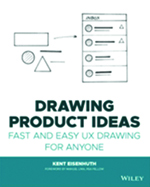 Drawing Product Ideas: Fast and Easy UX Drawing for Anyone
Drawing Product Ideas: Fast and Easy UX Drawing for Anyone
Kent Eisenhuth. 2023. John Wiley & Sons, Inc. [ISBN 978-1-119-83585-1. 192 pages, including index. US$30.00 (softcover).]
Drawing Product Ideas: Fast and Easy UX Drawing for Anyone teaches basic drawing skills to illustrate new concepts. The book is aimed at user experience (UX) designers, but the techniques are useful for anyone who needs to visually convey information.
Kent Eisenhuth has an impressive background in design leadership at Google; he pulls from these experiences to provide a solid range of user interface examples. Ten brief chapters contain hundreds of line drawings broken down into basic shapes and techniques. He assumes no previous knowledge of drawing, so even a beginner can execute these elements.
First, Eisenhuth makes a case for drawing as a design tool. Drawing, he argues, is the perfect medium for comprehension, collaboration, and iteration (pp. 5–7). Humans process information more easily in a visual format, which allows you to clearly convey your concept to your team. This leads, in turn, to meaningful collaboration during which the design can be refined. Finally, drawing is low stakes in time and resources: as you collaborate, you can iterate versions to integrate feedback quickly without the need for digital prototypes.
Next, Eisenhuth introduces the most common drawing types: diagrams for outlining site maps, processes, or systems; mind maps for organizing ideas; and digital interfaces and components. Even non-designers can use drawings to illustrate processes or information within their organization.
Chapters three and four cover the most essential elements of drawing: lines, points, and rectangles. Numerous illustrations give tips on breaking down depict interfaces and diagrams into their core shapes. Eisenhuth breaks down how simple shapes can be combined in new ways to create app interfaces, forms, and charts. Chapter five introduces circles, triangles, and more advanced shapes such as map pins and pointer hand cursors. He breaks advanced shapes down into manageable steps that anyone can follow.
After covering basic drawing, Eisenhuth demonstrates how to combine techniques to tell stories through your drawings. Showing user interaction and transitions between screens “help[s] strengthen people’s mental model” making them more sure of how it works (p. 145). Providing clear labels sparingly when needed can also improve comprehension. Using specific techniques to imbue your drawings with positive emotion can make people more receptive to your ideas; for example, when illustrating a chart, have the values climb upward from left to right to “invoke a feeling of positivity” (p. 167).
Drawing Product Ideas is a practical, useful introduction to basic drawing techniques for bringing new ideas to life. Overall, Eisenhuth makes a good case for drawing as a design tool. Simple instructions and examples make this book easy to follow. I recommend this for product designers and collaborators, but anyone who needs to construct visual aids within their organization will find these skills useful for brainstorming and process mapping.
Bonnie Winstel
Bonnie Winstel is the Assistant Manager of Software Development for Book Systems, Inc. in Huntsville, Alabama. She received her master’s degree in English and Technical Communication at the University of Alabama-Huntsville in 2013.

